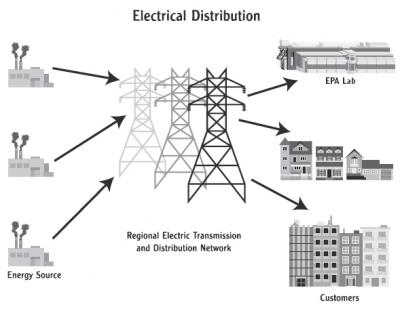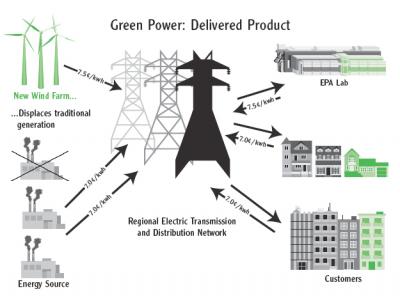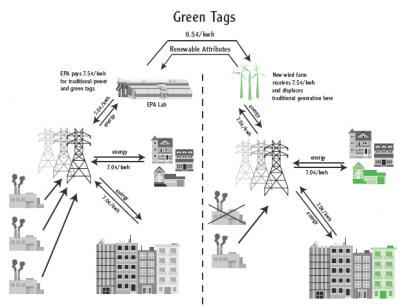I recently got this email from Art.
I am confused when I see “Vail Resorts: 100% Powered by Wind” and then read that the mechanism is some sort of credit.
Is there a simple explanation of the difference between buying credits and actually using wind power?
Art
I have also recently gotten some comments from Rosa asking about green credits or green tags.
Green Tags
Green tags, or green credits, or Renewable energy credits, are often used by companies to claim they are offsetting there carbon emission by using green power. The difference between green power and green tags can be subtle, but here is some info that will help understand the difference.
First some info from the EPA click here for the full pdf, click on images below for full size image.
Green Power: Tags vs. Delivered Products
The benefit of green power (whether it is a delivered product or a green tag) is that electricity generated by a source that has lower emissions and/or fewer environmental impacts reduces the need for electricity generated by a source that causes higher emissions and/or has greater environmental impacts. The difference between green power as a “delivered product†and a “green tag,†however, can be subtle and complicated.
The Basics: Electrical Transmission and Distribution
Electricity enters the power grid through a large number of power generation plants. These plants supply electricity to a large network of transmission and distribution lines, which transmit energy to thousands of end users. Since the electricity from each power plant flows throughout the entire distribution system, end users have no way of knowing which plant generates their power. For example, if ABC Utility Co.’s distribution network is fed by three power plants, a customer of ABC could receive electrons from any or all of the three sources.
The Two Types of Green Power: Delivered Products vs. Tags
To understand the following examples, assume the following:
1) Green power generally costs slightly more than the market rate for conventional power,
2) The market price of conventional electricity is 7 cents per kilowatt hour (kWh), and
3) The cost to produce wind power is 7.5 cents per kWh.
Delivered Product
When we say green power is delivered or is a “delivered product,†it means that the green power is fed into the same electric transmission and distribution system that serves the end user. For example, a local wind farm feeds its generated power into the local transmission and distribution system of the local utility, which sells and delivers electricity to a local EPA laboratory. Since the wind power enters the same grid from which the laboratory receives its electricity, the laboratory is said to receive a “delivered†product. While there is no direct electric line between the green power source and the purchaser, green power enters the local grid and replaces electricity that would have been generated from power sources with greater environmental impacts. The purchaser of green power pays more (7.5 cents per kWh) because it costs slightly more to produce the green power.
Green Tags
Suppose now that the EPA laboratory wants to buy green power, but cannot obtain a “delivered†green power product from its local electricity supplier. EPA can still obtain the environmental benefits of green power through the purchase of “Green Tags†from a wind farm owned by another utility and located in another state. That utility is not interconnected with the local utility supplying the EPA laboratory. The EPA laboratory will continue to buy electricity generated by conventional sources from its local utility at the market rate of 7 cents per kWh. EPA will also buy Green Tags from the wind farm in the adjacent state for 0.5 cents per kWh. The wind farm sells its power to its local customers at 7 cents per kWh (the market rate for conventional electricity) and its environmental attributes from the wind farm to EPA for 0.5 cents per kWh. The wind farm receives the full cost of producing wind power (7.5 cents per kWh) and displaces the high emissions of a conventional power plant. EPA receives conventional power, but it also achieves the emissions reductions associated with the wind farm, i.e. the Green Tag, for a total cost of 7.5cents per kWh. In each case, generation from a source with greater environmental impacts is replaced by that of a source with fewer environmental impacts.
See also:
Wikipedia article on green tags
American wind energy association article on buying wind tags



It is clear here that the only way green tags would represent an “offset” of your electricity use would be if you paid the full 7.5 cents and the green energy were fed into the grid for free.
Otherwise, as I pointed out before and these diagrams make clear, you’re simply donating a ha’penny to the green energy producer (who’s already sold the electricity for 7 cents) and not changing the mix of energy in the grid at all.
Rosa: here is the part you missed, clearly this does replace electricity produced by coal, oil, or gas.
“Since the wind power enters the same grid from which the laboratory receives its electricity, the laboratory is said to receive a “delivered†product. While there is no direct electric line between the green power source and the purchaser, green power enters the local grid and replaces electricity that would have been generated from power sources with greater environmental impacts. The purchaser of green power pays more (7.5 cents per kWh) because it costs slightly more to produce the green power.”
Except the purchaser of the power in the model described is not paying more, because the purchaser of the green tags is paying the “premium.” If the green tags weren’t sold, the purchaser of the power would still be purchasing the power — the producer just wouldn’t be making as much money.
So, again, the purchase of green tags does not add more green energy to the grid, it just makes it more profitable.
The point of buying green tags is not to add more energy to the grid, its to purchase the benefits of green energy.
The wind farm is going to sell the power for 7.5 cents no matter what, in the green tag model they just sell 7 cents of it to someone on the local grid, and .5 cents of it to someone else not on the local grid. They don’t make any more money than they would otherwise. If you have a local wind farm, and they sell green tags, you (being on the local grid) are actually going to pay less for your energy.
The reason someone would spend the extra .5 cents even if they are not going to get that power, is because they want to offset the harmful effects of there local grid supplied energy (from coal oil or gas). They are paying to lower the cost of wind energy someplace else in the hopes that this will increase the demand for wind energy and cause more wind farms (or solar fields or any renewable) to be built.
Even by your view of the model, the green tag purchaser is “offsetting” only 1/15 of his or her electricity use. Yet they claim 100% offset.
Green tags sounds like a scam. There is no additional amount of green energy being produced, the same amount of net pollution is still being made regardless of the purchase of green tags or not. Buying green tags gives the purchaser the feel that they aren’t polluting while still getting their energy from coal. The whole argument adds the element of magic that by buying a green tag C02 is magically taken out of the air despite the lack of any additional wind turbines being produced from the tags.
The better alternative is to spend what you would on the green tags on more efficient appliances or facilities. That way less power would be taken from the coal facilities and less CO2 would be put into the air. There is no loss in pollution from the purchase of green tags.
Doug, you are right that energy efficiency is very important, but green tags do in fact offset co2. If you read the post above you will see why.
No, I don’t see how it offsets CO2. I get all my power from nuclear, but if I get a green tag that doesn’t mean I’m getting power from a renewable source, it’s all still coming from nuclear. I’m just paying for a product where I get nothing in return.
Green tags appear to be nothing more than a feel good placebo allowing people to pollute but feel like they aren’t polluting.
The real effect comes from making green power competitive with coal. At some point if there are enough green tags purchased, then it will sway someone’s decision to build a wind turbine – or it will speed the decision up. When you get green power plants built ‘ahead of their time’ or in place of a conventional plant, that’s when we see a benefit.
Cooldriver sells green tags ahead of time, and when they have enough to cover all the green tags that a turbine will produce in it’s life, then they build a turbine, and the green benefit is considered ‘pre-sold’. This may be the direct effect that you’re looking for.
The shame of it all is that coal plants would not be competitive with green power if they were not receiving a bunch of subsidies to clean up their emissions. In other words if coal plants actually had to pay to keep their emissions in check, they would not be competitive.
Anything is progress.
I can see the idea of green tags to spur investment in green power since the folks who want to purchase green power might not be in the same direct transmission line as the most cost effective place to site a green power facility.
However, I have a concern about “double dipping.” Is there a regulatory agency who makes sure that someone is not trying to sell their green power both at a higher “direct transmission-green power” premium and then also “double dipping” by trying to get away with selling offsets too?
Another question about tags vs. direct transmission:
With direct transmission, it seems that often the utility sells a “green power” mix, often from a variety of sources. Some of which may be more “green” than others – such as you envision getting all wind or solar power and instead get most landfill gas (which is much better than letting that gas escape as a greenhouse gas, but may not be the renewable energy you envisioned getting).
Would a big advantage of a tag be that you could get it from a single facility that is exactly what you were envisioning (e.g. Company X’s wind farm)? Or are most distributors of “green tags” also bundling from a variety of generators which may or may not be what you thought you were getting?
Any insight would be greatly appreciated.